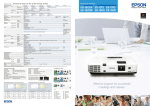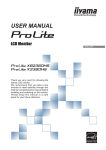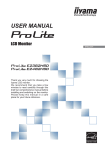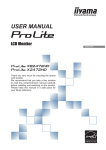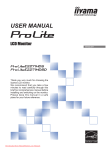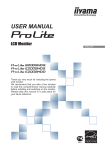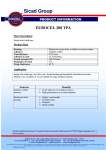Download USER MANUAL
Transcript
USER MANUAL ENGLISH Thank you very much for choosing the iiyama LCD monitor. We recommend that you take a few minutes to read this comprehensive manual carefully before installing and switching on the monitor. Please keep this manual in a safe place for your future reference. ENGLISH CE MARKING DECLARATION OF CONFORMITY This LCD monitor complies with the requirements of the EC Directive 2004/108/EC “EMC Directive” and 2006/95/EC “Low Voltage Directive”. Warning This is a class A product. In a domestic environment this product may cause radio interference in which case the user may be required to take adequate measures. ENGLISH IIYAMA CORPORATION: Breguetlaan 8, 1438BC Oude Meer The Netherlands We recommend recycling of used product. Please contact your dealer or iiyama service center. Recycle information is obtained via the Internet, using the address: http://www.iiyama.com You can access the Web page of different countries from there. We reserve the right to change specifications without notice. All trademarks used in this user manual are the property of their respective owners. ENGLISH TABLE OF CONTENTS FOR YOUR SAFETY..........................................................................1 SAFETY PRECAUTIONS..............................................................1 SPECIAL NOTES ON LCD MONITORS .......................................3 CUSTOMER SERVICE .................................................................3 CLEANING ....................................................................................3 BEFORE YOU OPERATE THE MONITOR ........................................4 FEATURES....................................................................................4 CHECKING THE CONTENTS OF THE PACKAGE ......................4 UNPACKING .................................................................................5 SPECIAL NOTES ON : ProLite T5561MTS...................................5 CONTROLS AND CONNECTORS : MONITOR ............................6 INSTALLATION .............................................................................8 CONTROLS AND CONNECTORS : REMOTE CONTROL.........10 PREPARING THE REMOTE CONTROL..................................... 11 BASIC OPERATION ....................................................................12 CONNECTING YOUR MONITOR ...............................................15 COMPUTER SETTING ...............................................................17 OPERATING THE MONITOR...........................................................18 ADJUSTMENT MENU CONTENTS ............................................20 SCREEN ADJUSTMENTS ..........................................................31 POWER MANAGEMENT FEATURE ...........................................34 TROUBLE SHOOTING ....................................................................35 RECYCLING INFORMATION...........................................................36 APPENDIX ......................................................................................37 SPECIFICATIONS : ProLite T5561MTS ......................................37 SPECIFICATIONS : ProLite L5561S ...........................................38 DIMENSIONS ..............................................................................39 COMPLIANT TIMING ..................................................................40 FOR YOUR SAFETY SAFETY PRECAUTIONS WARNING If you notice any abnormal phenomena such as smoke, strange sounds or fumes, unplug the monitor and contact your dealer or iiyama service center immediately. Further use may be dangerous and can cause fire or electric shock. NEVER REMOVE THE CABINET High voltage circuits are inside the monitor. Removing the cabinet may expose you to the danger of fire or electric shock. DO NOT PUT ANY OBJECT INTO THE MONITOR Do not put any solid objects or liquids such as water into the monitor. In case of an accident, unplug your monitor immediately and contact your dealer or iiyama service center. Using the monitor with any object inside may cause fire, electric shock or damage. INSTALL THE MONITOR ON A FLAT, STABLE SURFACE The monitor may cause an injury if it falls or is dropped. DO NOT USE THE MONITOR NEAR WATER Do not use where water may be splashed or spilt onto the monitor as it may cause fire or electric shock. OPERATE UNDER THE SPECIFIED POWER SUPPLY Be sure to operate the monitor only with the specified power supply. Use of an incorrect voltage will cause malfunction and may cause fire or electric shock. PROTECT THE CABLES Do not pull or bend the power cable and signal cable. Do not place the monitor or any other heavy objects on the cables. If damaged, the cables may cause fire or electric shock. ADVERSE WEATHER CONDITIONS It is advisable not to operate the monitor during a heavy thunder storm as the continual breaks in power may cause malfunction. It is also advised not to touch the plug in these circumstances as it may cause electric shock. FOR YOUR SAFETY 1 ENGLISH STOP OPERATING THE MONITOR WHEN YOU SENSE TROUBLE CAUTION INSTALLATION LOCATION Do not install the monitor where sudden temperature changes may occur, or in humid, dusty or smoky areas as it may cause fire, electric shock or damage. You should also avoid areas where the sun shines directly on the monitor. ENGLISH DO NOT PLACE THE MONITOR IN A HAZARDOUS POSITION The monitor may topple and cause injury if not suitably located. Please also ensure that you do not place any heavy objects on the monitor, and that all cables are routed such that children may not pull the cables and possibly cause injury. MAINTAIN GOOD VENTILATION Ventilation slots are provided to keep the monitor from overheating. Covering the slots may cause fire. To allow adequate air circulation, place the monitor at least 10 cm (or 4 inches) from any walls. Do not remove the tilt stand when operating the monitor. Ventilation slots on the back of the cabinet will be blocked and the monitor may overheat if the stand is removed. This may cause fire or damage. Operating the monitor on its back, side, upside down or on a carpet or any other soft material may also cause damage. DISCONNECT THE CABLES WHEN YOU MOVE THE MONITOR When you move the monitor, turn off the power switch, unplug the monitor and be sure the signal cable is disconnected. If you do not disconnect them, it may cause fire or electric shock. UNPLUG THE MONITOR If the monitor is not in use for a long period of time it is recommended that it is left unplugged to avoid accidents. HOLD THE PLUG WHEN DISCONNECTING To disconnect the power cable or signal cable, always pull it by the plug. Never pull on the cable itself as this may cause fire or electric shock. DO NOT TOUCH THE PLUG WITH WET HANDS Pulling or inserting the plug with wet hands may cause electric shock. WHEN YOU INSTALL THE MONITOR ON YOUR COMPUTER Be sure the computer is strong enough to hold the weight of the monitor, otherwise, you may damage your computer. DO NOT USE THE MONITOR FOR 24-HOURS CONTINUOUSLY The monitor is not designed to work for 24-hours continuously, do not use the monitor for 24-hours continuously. OTHERS ERGONOMIC RECOMMENDATIONS To eliminate eye fatigue, do not operate the monitor against a bright background or in a dark room. For optimal viewing comfort, the monitor should be just below eye level and 40-60 cm (16-24 inches) away from your eyes. When using the monitor over a prolonged time, a ten minute break every hour is recommended as looking at the screen continuously can cause eye strain. 2 FOR YOUR SAFETY SPECIAL NOTES ON LCD MONITORS NOTE When you first turn on the LCD monitor, the picture may not fit in the display area because of the type of computer that is used. In this case, adjust the picture position to the correct position. Due to the nature of the backlight, the screen may flicker during initial use. Turn off the Power Switch and then turn it on again to make sure the flicker disappears. You may find slightly uneven brightness on the screen depending on the desktop pattern you use. Due to the nature of the LCD screen, an afterimage of the previous screen may remain after switching the image, when the same image is displayed for hours. In this case, the screen is recovered slowly by changing the image or turning off the Power Switch for hours. Contact your dealer or iiyama service center for the backlight replacement when the screen is dark, flickering or not lighting up. Never attempt to replace it by yourself. CUSTOMER SERVICE NOTE The fluorescent light used in the LCD monitor may have to be periodically replaced. For the warranty coverage on this component, please check with local iiyama service center. If you have to return your unit for service and the original packaging has been discarded, please contact your dealer or iiyama service center for advice or replacement packaging. CLEANING If you drop any materials or liquids such as water into the monitor when cleaning, WARNING unplug the power cable immediately and contact your dealer or iiyama service center. CAUTION For safety reasons, turn off the power switch and unplug the monitor before you clean it. NOTE To protect the LCD panel, do not scratch or rub the screen with a hard object. Never use any of the following strong solvents. These will damage the cabinet and the LCD screen. Thinner Spray-type cleaner Benzine Wax Abrasive cleaner Acid or Alkaline solvent Touching the cabinet with any product made from rubber or plastic for a long time may cause degeneration or loss of paint on the cabinet. CABINET Stains can be removed with a cloth lightly moistened with a mild detergent solvent. Then wipe the cabinet with a soft dry cloth. LCD Periodic cleaning with a soft dry cloth is recommended. Don't use tissue paper etc. because these will damage the LCD screen. SCREEN FOR YOUR SAFETY 3 ENGLISH The following symptoms are normal with LCD monitors and do not indicate a problem. BEFORE YOU OPERATE THE MONITOR FEATURES Supports Resolutions up to 1920 × 1080 2 High Contrast 4000:1 (Typical: with Touch panel) / Brightness 400cd/m (Typical: with Touch panel) : ProLite T5561MTS 2 High Contrast 5000:1 (Typical) / Brightness 500cd/m (Typical) : ProLite L5561S ENGLISH Digital Character Smoothing Automatic Set-up Stereo Speakers 2 × 10W Stereo Speakers Plug & Play VESA DDC2B Compliant Windows® 95/98/2000/Me/XP/Vista/7 Compliant Power Management (VESA DPMS Compliant) VESA Mounting Standard (600mm×400mm, 400mm×400mm) Compliant Supports Displayport Ver. 1.1 CHECKING THE CONTENTS OF THE PACKAGE The following accessories are included in your package. Check to see if they are enclosed with the monitor. If anything is missing or damaged, please contact your local iiyama dealer or regional iiyama office. 1 Power Cable* D-Sub Signal Cable HDMI Cable USB Cable*2 iiyama Logo Sticker Remote Control Safety Guide 2 Touch Pen* Quick Start Guide CAUTION *1 The rating of the Power Cable enclosed in 120V area is 10A/125V. If you are using a power supply higher than this rating, then a power cable with a rating of 10A/ 250V must be used. However, all guarantees and warranties are void for any problems or damage caused by a power cable not supplied by iiyama. *2 Accessory for ProLite T5561MTS. 4 BEFORE YOU OPERATE THE MONITOR UNPACKING Before unpacking your monitor, prepare a stable, level, and clean surface near a wall outlet. Set the LCD Monitor box in an upright position and open from the top of the box before removing the top cushions. Remove the white handle(s) and cut the banding. Remove the top cushion and take the accessories bag Pull the handle CAUTION Moving the monitor requires at least two people. If not, it may drop and could result in a serious injury. When moving/shipping the monitor, please hold by the white handles. SPECIAL NOTES ON : ProLite T5561MTS CAUTION Permanent damage can occur if Sharp Edged, Pointed or Metal items are used to activate Touch. This could invalidate any remaining warranty. We recommend you use a plastic stylus (tip R0.8 or over) or finger. BEFORE YOU OPERATE THE MONITOR 5 ENGLISH and the Monitor out. CONTROLS AND CONNECTORS : MONITOR <Side Controller> Power Button SOURCE Input Select Button Right Button Left Button ENGLISH Up Button Down Button MENU / EXIT Menu/Exit Button <Front> Power Indicator Green Normal Operation Orange Power Management If power off and select LED on via menu "Front LED ON" Off Power Off If power on and select LED on via menu "Front LED OFF" Remote Sensor Remote Sensor Touch USB <Right Side > Touch USB* Touch USB Connector * Available for ProLite T5561MTS only. 6 BEFORE YOU OPERATE THE MONITOR ENGLISH <Back> RS232C RS485 In RS485 Out ON DisplayPort HDMI1 HDMI2 DVI VGA PC IR Audio In Extender Line Out Component Video R L R S-Video Video L Composite Audio Component Audio AC OUT 100-200V2A DisplayPort DisplayPort DisplayPort Connector HDMI1 HDMI HDMI Connector HDMI2 HDMI HDMI Connector DVI DVI-D 24pin DVI-D 24pin Connector VGA D-SUB mini 15pin D-SUB mini 15pin Connector PC Audio In Mini Jack Audio Connector IR Extender Mini Jack IR Extender Connector Line Out Mini Jack Audio output Connector Component Video RCA G(Y)/B(Pb)/R(Pr) Component Video Connector Component Audio RCA L/R Component Audio Connector S-Video Mini Din 4pin S-Video Connector Video RCA Video Connector Composite Audio RCA L/R Composite Audio Connector AC OUT AC Connector (AC-IN) (OFF) Main Power Switch RS232C In D-SUB 9pin RS232C Connector RS485 In RJ-45 RS485 input Connector RS485 Out RJ-45 Handles OFF AC Connector (AC-OUT) AC IN (ON) / AC IN RS485 output Connector Handles BEFORE YOU OPERATE THE MONITOR 7 INSTALLATION ENGLISH CAUTION Follow the manual instructions for the type of mount you have selected. Refer all servicing to qualified service personnel. Moving the monitor requires at least two people. Before installing, please make sure the wall is strong enough to hold the necessary weight of the display and the mount. Using a screw longer than this may cause electric shock or damage because it may contact with the electrical parts inside the monitor. Remove the screws (M8x15 x8) from the back of the monitor if necessary, and please use those. Screw (M8 x15) x8 8 BEFORE YOU OPERATE THE MONITOR [Installation Note] *Available for ProLite T5561MTS only. The touch kit of this monitor is an optical device that utilizes infrared light source and sensitive sensors for touch detection. Notice the incident light that contains large quantities of infrared light may affect touch screen operation and performance. Light source ENGLISH Please install it with care as follows to ensure reliable touch performance. Intense light / Specular light / Focus spotlight / Wide spread light / Direct sunlight / Indirect sunlight from the window and/or the glass door. / Not install the touch monitor right under the light source. Light source Light source Front Windows Front Side [Rotating the Display] Direct Sunlight Side *Available for ProLite L5561S only. It is designed to be compatible in both landscape and portrait modes, however, it is optimized for landscape mode. Note that the OSD orientation can be changed in the OSD menu, and it must be rotated clockwise when rotate it into portrait. A A A A Not Available Available Landscape Portrait BEFORE YOU OPERATE THE MONITOR 9 CONTROLS AND CONNECTORS : REMOTE CONTROL ENGLISH Turns the monitor ON and OFF. VGA / DVI / HDMI1 / COMP1 / AV1(VIDEO1) / HDMI2 Selects the source. ECO+ Brightness of back-light is reduced. ECO- Brightness of back-light is increased. P-SOURCE Selects the secondary sub source. MENU Opens the monitor's on-screen menu systems. When the menu system is already open, pressing this button will select the previous submenu. MENU Navigates through submenus and settings. : Up Button : Down Button : Left Button : Right Button 10 BEFORE YOU OPERATE THE MONITOR EXIT Closes the menu system. INFO Provides source and resolution information. P-POSITION Move the sub screen display area. DISPLAYPORT Select the DisplayPort input. PIP Turns the PIP feature ON and OFF. S-V Selects the S-Video source. SWAP Swaps the main source and sub source picture. ENTER Selects highlighted menu choices. SCALING Toggles between different aspect ratios. Auto / Native / 4x3 / 16x9 / 16x10 / Letter Box FREEZE Freezes the current source image. MUTE Turns off the sound. BRIGHT Adjusts the brightness. CONTRAST Adjusts the contrast. AUTO Synchronizes the monitor to the source. SOURCE Allows selection of the different sources. VOLUME- Decreases the sound volume. VOLUME+ Increases the sound volume. PREPARING THE REMOTE CONTROL To use the remote control, insert the two dry batteries. CAUTION Slide back and remove the battery cover in the direction of the arrow. Align and insert two AAA batteries according to their plus and minus ports (as indicated in the remote control). Battery x 2 (Not included) Replace the battery cover in the direction of the arrow and snap it back into place. NOTE Replace with new batteries when the Remote Control does not work close to the monitor. Use AAA dry batteries. Operate the Remote Control by pointing it toward the Remote Sensor on the monitor. Other manufacturers remote control will not work with this monitor. Use the provided Remote Control ONLY. Used batteries needed to follow the city rule to be discarded. (suggestion: to dispose of used batteries please follow correct policy as per your council regulations) BEFORE YOU OPERATE THE MONITOR 11 ENGLISH Do not use any other batteries other than those specified in this manual for the Remote Control. Do not insert old and new batteries together in the Remote Control. Make sure that the terminals match the "+" and "-" indications in the battery compartment. Burst batteries or the electrolyte from these batteries may cause stains, fire or injury. BASIC OPERATION ENGLISH Turning the monitor ON [Monitor] [Remote Control] The monitor is turned On and the Power Indicator turns to Green when you press the Power Button on the monitor or the Remote Control. The monitor is turned Off and the Power Indicator turns to orange when you press the Power Button on the monitor or the Remote Control. Press again to turn On the monitor. MENU NOTE Even when using the power management mode or turning OFF the Power Switch, the monitor will consume a small amount of electricity. Disconnect the Power Cable from the power supply whenever the monitor is not in use or during the night, to avoid unnecessary power consumption. Display the adjustment menu page [Monitor] [Remote Control] The menu page appears on the screen when you press the MENU Button on the monitor or the Remote Control. The menu page disappears when you press the EXIT Button on the monitor or the Remote Control again. MENU 12 BEFORE YOU OPERATE THE MONITOR Move the cursor vertically [Monitor] [Remote Control] MENU Move the cursor horizontally [Monitor] [Remote Control] Select menu or setting, or perform the / Button while adjustment by pressing the the menu page is displayed on the screen. MENU BEFORE YOU OPERATE THE MONITOR 13 ENGLISH Select adjustment by pressing the / Button while the menu page is displayed on the screen. Adjust the volume of sound [Remote Control] Press the Volume+ / Volume- Button on the Remote Control to adjust the volume of sound when the menu page is not displayed on the screen. ENGLISH MENU Switch the input signal [Monitor] [Remote Control] This is activated when you successively press the Source Button on the monitor or Input Signal Button on the Remote Control as follows: MENU 14 BEFORE YOU OPERATE THE MONITOR CONNECTING YOUR MONITOR NOTE The signal cables used for connecting the computer and monitor may vary with the type of computer used. An incorrect connection may cause serious damage to both the monitor and the computer. The cable supplied with the monitor is for a standard 15 pin D-Sub connector. If a special cable is required please contact your local iiyama dealer or regional iiyama office. For connection to Macintosh computers, contact your local iiyama dealer or regional iiyama office for a suitable adaptor. Make sure you tighten the finger screws at each end of the Signal. Don't connect the RS-232C cable and the USB cable to the computer at the same time. And cannot use those at the same time. When USB cable connected than wait for 5 seconds and the touch function is ready to go. It can be activated by pen, finger or any other pointer. [Example of Connection] <Back> GAME Equipment HDMI Cable (Not Included) Power Cable (Accessory) AV Equipment HDMI Cable (Accessory) DisplayPort Cable (Not Included)*2 DVI-D Cable (Not Included) D-Sub Signal Cable (Accessory) Audio Cable (Not Included) Computer USB Cable (Accessory) *1 *1 Available for ProLite T5561MTS only. *2 Please use the cable which supported Displayport Ver. 1.1. BEFORE YOU OPERATE THE MONITOR 15 ENGLISH Ensure that both the computer and the monitor are switched off. Connect the computer to the monitor with the signal cable. Connect the computer to the monitor with the USB Cable. *1 Connect the Power Cable to the monitor first and then to the power supply. Turn on your monitor (Main Power Switch and Power Switch) and computer. [ Connection example with the peripheral device ] CAUTION Turn off the power switch and unplug the monitor and peripherals before connection to avoid electric shock or damage. NOTE Refer to the user manual of peripherals at the same time. ENGLISH Ensure you have the necessary cables as required. RS485 In RS232C 16 BEFORE YOU OPERATE THE MONITOR Red White Yellow S-Video Red Component Video R L R S-Video Video L Composite Audio Component Audio Red White Line Out Blue PC IR Audio In Extender Green VGA RS485 Out COMPUTER SETTING Windows XP/Vista/7 Plug & Play : ProLite T5561MTS Windows 95/98/2000/Me/XP/Vista/7 Plug & Play : ProLite L5561S The iiyama LCD monitor complies with DDC2B of VESA standard. The Plug & Play function runs on Windows 95/98/2000/Me/XP/Vista/7 by connecting the monitor to DDC2B compliant computer with the Signal Cable supplied. For installation on Windows 95/98/2000/Me/XP: The monitor Information File for iiyama monitors may be necessary for your computer and obtained via the Internet, using the address: http://www.iiyama.com NOTE For additional information on how to download the driver for your touch screen monitor, please access the internet site noted above. Monitor Drivers are not required in most cases for Macintosh or Unix operating systems. For further information, please contact your computer dealer first for advice. Procedure for turning ON the Power Switch Turn ON the monitor first, and then the computer. MULTI-TOUCH : ProLite T5561MTS This monitor complies with DDC2B of VESA standard. (Plug&play compliant) The MULTI-TOUCH function runs on Windows7 by connecting the monitor to DDC2B compliant computer with the USB cable supplied. MULTI-TOUCH support operation system : ProLite T5561MTS Microsoft Windows XP (64 bit and 32 bit) Microsoft Windows Vista (64 bit and 32 bit) Microsoft Windows 7 (64 bit and 32 bit) Mac OS X V10.4 & above Linux (2.6x) & above Not support Windows 2000 and earlier versions. Windows7*4 Windows7*5 Vista XP Mac OSX Linux Default mouse*1 Touch digitizer*2 Windows7 gestures*3 *1 Default mouse (click, drag, double-click and right-click) *2 Touch digitizer (click, drag /selection, double-click, right-click, flick and visual feedback) *3 Digitizer with Windows7 multi-touch gestures *4 Windows 7 - Starter and Home Basic version *5 Windows 7 - Home Premium, Professional, Enterprise and Ultimate versions BEFORE YOU OPERATE THE MONITOR 17 ENGLISH Signal Timing Change to the desired signal timing listed on page 40: COMPLIANT TIMING. OPERATING THE MONITOR To create the best picture, your iiyama LCD monitor has been preset at the factory with the COMPLIANT TIMING shown on page 40. You are also able to adjust the picture by following the button operation shown below. For more detailed adjustments, see page 31 for SCREEN ADJUSTMENTS. Press the MENU Button to start the On Screen Display feature. There are additional / Buttons. Menu items which can be switched by using the Image Settings User ENGLISH Scheme Brightness 50 Contrast 50 Sharpness 12 Saturation Hue Backlight 100 Colour Temperature & Gamma or ENTER B Select the Menu item of the adjustment you want to make. Press the / Buttons to highlight the Buttons and enter the menu page. Then, use the desired adjustment item. or ENTER Buttons again. Use the C Press the appropriate adjustment or setting. / Buttons to make the D Press the EXIT Button to leave the menu, and the settings you just made would be automatically saved. For example, to correct for vertical position, select Menu item of Advanced Settings. Then, select Image Position by using the Buttons. Use the Buttons to change the vertical position settings. The vertical position of the overall / display should be changing accordingly while you are doing this. Press the EXIT Button lastly, it ends, any changes are saved in the memory. Advanced Setting Auto Adjustment Image Position No Image Position Phase 46 50 Clock VGA ADC Settings Flesh Tone Off IRFM Off Baud Rate 115200 Light Sensor Off WOD Mode Off Monitor ID 1 Factory Reset 0 0 No NOTE The MENU Button can be used to return previous menu item. When button operations are aborted during adjustment, On-Screen Display disappears when the time set for the OSD Timeout has passed. EXIT button can be used to return previous menu item. Any changes are automatically saved in the memory when the On Screen Display disappears. Turning off the power should be avoided while using the Menu. Adjustments for Image Position, Clock and Phase are saved for each signal timing. Except for these adjustments, all other adjustments have only one setting which applies to all signal timings. 18 OPERATING THE MONITOR ENGLISH OSD LOCK MODE: LOCK: Press ENTER, ENTER, EXIT, EXIT, ENTER and EXIT on the Remote Control in sequence and OSD will be locked. UNLOCK: Press ENTER, ENTER, EXIT, EXIT, ENTER and EXIT on the Remote Control in sequence and OSD will be Unlocked. OPERATING THE MONITOR 19 ADJUSTMENT MENU CONTENTS Image Settings Image Settings User Scheme Brightness 50 Contrast 50 Sharpness 12 Saturation Hue Backlight 100 ENGLISH Colour Temperature & Gamma Adjustment Item Scheme *2 Problem / Option Button to Press User Displays a picture on a screen set by Image Settings adjustments. Vivid For displaying outdoor scenery images. Cinema For movie and video environment. Game For PC game environment. Sport For sport environment. Brightness *1 Direct Too dark Too bright Contrast Direct Too dull Too intense Sharpness Too soft Too sharp Saturation *2 Too week Too strong Hue *2 Purplish Greenish Backlight Brightness of back light is reduced. Colour Temperature & Gamma Press Button. *1 Adjust the Brightness when you are using the monitor in a dark room and feel the screen is too bright. *2 Only COMP1, AV1 and s-v input. Direct You can skip the Menu items and display an adjustment scale directly by using the following button operations. Brightness: Press the BRIGHT Button (Remote Control) when the Menu is not displayed. Contrast: Press the CONTRAST Button (Remote Control) when the Menu is not displayed. 20 OPERATING THE MONITOR Image Settings Colour Temperature & Gamma Image Settings Adjustment Item Gamma Colour Temperature 2.2 User Red Gain 256 Green Gain 256 Blue Gain 256 Red Offset 0 Green Offset 0 Blue Offset 0 Problem / Option Off Button to Press High contrast 2.2 Normal User Go to adjustment menu of Gain and Offset. 5000K Greenish white 6500K Reddish white 7500K Yellowish white 9300K Bluish white Red Gain To gain Red Green Gain To gain Green Blue Gain To gain Blue Red Offset To offset Red Green Offset To offset Green Blue Offset To offset Blue OPERATING THE MONITOR 21 ENGLISH Gamma Colour Temerature Display Settings Display Settings Main Main Aspect Ratio Full Screen Zoom Auto Scan Off Select Source PIP PIP Mode Off PIP Position Top-Left Aspect Ratio Full Screen Side By Side Scale Auto Scan ENGLISH Select Source Adjustment Item Aspect Ratio Zoom Auto Scan Select Source Problem / Option Button to Press Full Screen Expansion display Native Letter Box Displayed at the same magnification. Landscape display Pillar Box Portrait display Zoom in the image Zoom out the image On Select the signal input automatically. Off Select the signal input manually. VGA Select the VGA input. HDMI1 Select the HDMI1 input. HDMI2 Select the HDMI2 input. DVI Select the DVI input. Displayport Select the Displayport input. Video Select the Video input. S-Video Select the S-Video input. Component Select the Component input. NOTE When only one of the seven signal inputs is connected to the signal source, the one connected is automatically selected. Select Source function is not available if there is no signal input from the selected connector or during the power management mode. 22 OPERATING THE MONITOR Display Settings Display Settings PIP Main Aspect Ratio Full Screen Zoom Auto Scan Off Select Source PIP PIP Mode Off PIP Position Top-Left Aspect Ratio Full Screen Side By Side Scale Auto Scan Adjustment Item PIP Mode * PIP Position Problem / Option Button to Press Off PIP function is turned off. Large PIP Sub screen is displayed at maximum size. Medium PIP Sub screen is displayed at normal size. Small PIP Sub screen is displayed at minimum size. Side by Side Main screen and sub screen are tiled. You can move the sub screen display area to any one of the following 4 positions within the overall display. Bottom-Right / Top-Right / Top-Left / Bottom-Left Full Screen Aspect Ratio Expansion display Letter Box Landscape display Pillar Box Portrait display Zoom In Zoom in the image. Zoom Out Zoom out the image. Main Select the Main screen. NOTE PIP Select the Sub screen. When select Side by Side in PIP Mode. Default Return this function to default. Return Return to Menu. On Select the signal input automatically. Off Select the signal input manually. Side by Side Scale Auto Scan Select Source VGA Select the VGA input. HDMI1 Select the HDMI1 input. HDMI2 Select the HDMI2 input. DVI Select the DVI input. Displayport Select the Displayport input. Video Select the Video input. S-Video Select the S-Video input. Component Select the Component input. NOTE When only one of the seven signal inputs is connected to the signal source, the one connected is automatically selected. Select Source function is not available if there is no signal input from the selected connector or during the power management mode. OPERATING THE MONITOR 23 ENGLISH Select Source *1 PIP = Picture in Picture With this function, you can display two different picture. Main Screen Main Screen Sub Screen ENGLISH Sub Screen Small Side by Side Middle Large PIP Screen Table Main Sub HDMI1 HDMI2 HDMI1 HDMI2 VGA DVI Displayport Component S-Video Video 24 OPERATING THE MONITOR VGA DVI Displayport Component S-Video Video Audio Settings Audio Settings Volume 50 Bass 10 Treble 10 Balance Adjustment Item 10 HDMI Problem / Option Button to Press Volume Too soft Too loud Bass Too weak Too strong Treble Too weak Too strong Balance Adjust the volume balance of the speaker right and left. HDMI Audio Input * HDMI Select the HDMI input. PC Select the PC input. * Suitable for HDMI input only. OPERATING THE MONITOR 25 ENGLISH HDMI Audio Input Basic Settings Basic Settings OSD Transparent 0 OSD Location OSD Zoom Off Landscape OSD Rotation OSD Language English OSD Timeout 120Sec. Sleep Timer Off Power LED Off Real Time Clock ENGLISH Start Up Logo Adjustment Item On Problem / Option Button to Press OSD Transparent Too opaque Too transparent OSD Location Adjust the menu location on the screen. OSD Zoom On Zoom in the OSD. Off OSD Zoom is turned off. NOTE OSD Zoom disabled when setting portrait of OSD Rotation. Landscape Normal OSD Rotation OSD Language Menu screen is rotated 90 degrees in counter clockwise. Portrait English English Deutsch Français French Polski Nederlands Dutch German Polish Russian OSD Timeout You can set the OSD display duration time between 5 and 120 seconds. Sleep Timer Set a period of time after which the monitor will switch to stand by mode automatically. Off/15/30/60/90/120min Power LED On The power indicator is turned on. Off The power indicator is turned off. NOTE Turn Off the power indicator when you are bothered by the light. Set data, and switch alarm on and off. Real Time Clock / Buttons : Move the cursor horizontally / Buttons : Number select, Move the cursor vertically MENU Button: Return previous menu item On iiyama Logo displayed when the monitor is turned on. Off iiyama Logo does not display when the monitor is turned on. Start Up Logo 26 OPERATING THE MONITOR Advanced Settings Advanced Setting Auto Adjustment No Image Position Phase 46 50 Clock VGA ADC Settings Flesh Tone Off IRFM Off 115200 Baud Rate Light Sensor Off WOD Mode Off Monitor ID 1 Adjustment Item Auto Adjustment *1,2,4 Problem / Option Button to Press No Return to Menu. Yes Adjust Position, Clock and Phase automatically. Too far to the left Too far to the right Image Position *1 Too low Too high Phase *1 To correct flickering text or lines Too narrow Too wide Clock *1 VGA ADC Settings*4 Press Off Flesh Tone * 3 IRFM Baud Rate Monitor ID Flesh Tone is turned off. Low Emphasize flesh color. Medium Emphasize flesh color more. High Emphasize flesh color more than Medium. On Anti burn-in function is turned on. Off Anti burn-in function is turned off. Set the baud rate when connecting the RS232C connector and the monitor. 9600 / 19200 / 38400 / 115200 On When plein air lowering brightness is gloomy. And raise brightness when it is light. Off Light sensor is turned off. On The monitor can be configured to "Wake Up" when sent a digital signal through the Displayport, HDMI or DVI connectors. Off WOD Mode is turned off. Light Sensor WOD Mode Button. Set ID to the Monitor. 1-255 OPERATING THE MONITOR 27 ENGLISH No Factory Reset Advanced Settings Advanced Setting Auto Adjustment No Image Position Phase 46 50 Clock VGA ADC Settings Flesh Tone Off IRFM Off 115200 Baud Rate Light Sensor Off WOD Mode Off Monitor ID 1 ENGLISH Factory Reset Adjustment Item Factory Reset 1 No Problem / Option No Return to Menu. Yes Factory-preset data is restored. Button to Press * Only Analog input. *2 For best results, use the Auto Adjust in conjunction with the adjustment pattern. See page 31 for SCREEN ADJUSTMENTS. *3 Only COMP1, AV1 and s-v input. *4 Auto Adjustment and VGA ADC Settings disabled when PIP Mode is active. 28 OPERATING THE MONITOR Advanced Settings VGA ADC Settings Advanced Setting Default ADC Mode User ADC Calibration Adjustment Item ADC Mode User ADC Calibration*5 Restore ADC to Default Problem / Option Button to Press Default Factory Mode User User Setting Mode Press Press Button. No Return to Menu. Yes Set Calibration. No Return to Menu. Yes User ADC Calibration is restored to default. Button. *5 User ADC Calibration 1. A warning message (see image below) will show to make sure the proper image is displayed on screen before ADC calibration begins. i. Image in the green boxes, displayed on both side of the screen, has to be white and black in order to run the calibration accurately (the black and white image can be made using software such as Microsoft PowerPoint). ii. The white in the left green box has to be the brightest white. iii. The black in the right green box has to be the darkest black. Ready to run ADC Calibration? Yes No 2. After the proper image is displayed, click "Yes" to begin ADC calibration. 3. During calibration process, the following image will appear to notify user to wait for the calibration. 4. After calibration is completed, the display will notify user if the process has been successfully by a different message. OPERATING THE MONITOR 29 ENGLISH Restore ADC to Default System Status System Status Channel Information Source Main VGA ENGLISH Firmware Version Adjustment Item Problem / Option Resolution [email protected] V0.20d Button to Press Displays information regarding the current input signal coming from the graphic card in your computer. System Status NOTE See your graphic card user guide for more information about changing the resolution and refresh. 30 OPERATING THE MONITOR SCREEN ADJUSTMENTS The screen adjustments described in this manual are designed to set image position and minimize flicker or blur for the particular computer in use. The monitor is designed to provide the best performance at resolution of 1920 × 1080, but can not provide the best at resolutions of less than 1920 × 1080 because the picture is automatically stretched to fit the full screen. It is recommended to operate at resolution of 1920 × 1080 in normal use. Displayed text or lines will be blurred or irregular in thickness when the picture is stretched due to the screen enlargement process. It is preferable to adjust the image position and frequency with the monitor controls, rather than the computer software or utilities. Perform adjustments after a warm-up period of at least thirty minutes. Additional adjustments may be required after the Auto Adjust depending on the resolution or signal timing. The Auto Adjust may not work correctly when displaying the picture other than the screen adjustment pattern. In this case, manual adjustments are required. There are two ways to adjust the screen. One way is automatic adjustment for Position, Clocks and Phase. The other way is performing each adjustment manually. Perform the Auto Adjust first when the monitor is connected to a new computer, or resolution is changed. If the screen has a flicker or blur, or the picture does not fit in the display area after performing the Auto Adjust, manual adjustments are required. Both adjustments should be made by using the screen adjustment pattern (Test.bmp) obtained via the IIYAMA web site (http://www.iiyama.com). Adjust the image by following the procedure below to get the desired picture. This manual explains adjustment under Windows 95/98/2000/Me/XP/Vista/7. A Display the picture at the optimum resolution. B Enter the Test.bmp (screen adjustment pattern) to wallpaper. NOTE Consult the appropriate documentation for doing this. Test.bmp is made at resolution of 1280 × 1024. Set the display position to center in the wallpaper setting dialogue box. If you use Microsoft® PLUS! 95/98 cancel the setting of “Stretch desktop wallpaper to fit the screen”. [Adjustment pattern] Color bar Zebra pattern Picture frame OPERATING THE MONITOR 31 ENGLISH Adjust the image by following the procedure below to get the desired picture when selecting Analog input. C Press the AUTO Button. (Auto Adjustment : Remote Control) D Adjust the image manually by following procedure below when the screen has a flicker or blur, or the picture does not fit in the display area after performing the Auto Adjust. ENGLISH E Adjust the V-Position so that the top and bottom of the picture frame will fit to the display area. F 1) Adjust the H-Position so that the left side of the picture frame will move to the left edge of the display area. 2) Stretch the right side of the picture frame to the right edge of the display area by adjusting the Clock. NOTE When the left side of the picture frame moves apart from the left edge of the display area during the Clock adjustment, adjust steps 1) and 2). Another way to make the Clock adjustment is to correct the vertical wavy lines in the zebra pattern. The picture may flicker during the Clock, H/V-Position adjustment. In case the picture frame is bigger or smaller than the data display area after the Clock adjustment, repeat steps from C. 32 OPERATING THE MONITOR NOTE In case the strong flicker or blurs remain on a part of the screen, repeat steps F and G because the Clocks may not be adjusted correctly. If the flicker or blurs still remain, set the refresh rate of computer to low (60Hz) and repeat steps from C again. Adjust the H-Position after the Phase adjustment if the horizontal position moves during the adjustment. H Adjust the Brightness and Color to get the desired picture after you complete the Clock and Phase adjustments. Put back your favorite wallpaper. OPERATING THE MONITOR 33 ENGLISH G Adjust the Phase to correct horizontal wavy noise, flicker or blur in the zebra pattern. POWER MANAGEMENT FEATURE ENGLISH The power management feature of this product complies with power saving requirement of VESA DPMS. When activated, it automatically reduces unnecessary power consumption of the monitor when your computer is not in use. To use the feature, the monitor needs to be connected to a VESA DPMS compliant computer. There is a power management step the monitor takes as described below. The power management function, including any timer settings is configured by the operating system. Check your operating system manual for information on how this can be configured. Power Management Mode When the H-sync signal / V-sync signal / H and V sync signals from the computer are off, the monitor enters into Power Management Mode which reduces the power consumption to less than 1W. The screen becomes dark. From Power Management Mode, the image reappears in several seconds when either the keyboard or the mouse are touched again. Power Indicator NORMAL MODE Green POWER MANAGEMENT MODE Orange POWER 0 1W CONSUMPTION NOTE 100% Even when using the power management mode, the monitor consumes electricity. Turn off the Power Switch whenever the monitor is not in use, during the night and weekends, to avoid unnecessary power consumption. It is possible that the video signal from the computer may be on while the H or V sync signal is missing. In this instance, the POWER MANAGEMENT feature may not work properly. 34 OPERATING THE MONITOR TROUBLE SHOOTING If the monitor fails to operate correctly, please follow the steps below for a possible solution. 1. Perform the adjustments described in OPERATING THE MONITOR, depending on the problem you have. If the monitor does not get a picture, skip to 2. 2. Consult the following items if you cannot find an appropriate adjustment item in OPERATING THE MONITOR or if the problem persists. 3. If you are experiencing a problem which is not described below or you cannot correct the problem, discontinue using the monitor and contact your dealer or iiyama service center for further assistance. Check The picture does not appear. The Power Cable is firmly seated in the socket. The Power Switch is turned ON. The AC socket is live. Please check with another piece of equipment. If the blank screen saver is in active mode, touch the keyboard or the mouse. Increase the Contrast and/or Brightness. The computer is ON. The Signal Cable is properly connected. The signal timing of the computer is within the specification of the monitor. If the monitor is in power management mode, touch the keyboard or the mouse. The screen is not synchronized. The Signal Cable is properly connected. The signal timing of the computer is within the specification of the monitor. The video output level of the computer is within the specification of the monitor. The screen position is not in the center. The signal timing of the computer is within the specification of the monitor. The screen is too bright or too dark. The video output level of the computer is within the specification of the monitor. The screen is shaking. The power voltage is within the specification of the monitor. The signal timing of the computer is within the specification of the monitor. No sound. The audio equipment (computer etc.) is ON. The Audio Cable is properly connected. The Volume is turned up. The Mute is OFF. The audio output level of the audio equipment is within the specification of the monitor. The sound is too loud or too quiet. The audio output level of the audio equipment is within the specification of the monitor. A strange noise is heard. The Audio Cable is properly connected. T h e t o u c h screen shows no response. The USB Cable is firmly seated in the socket. Touch screen driver software is installed. The touch position does not deviate. The calibration function set up correctly. TROUBLE SHOOTING 35 ENGLISH Problem RECYCLING INFORMATION ENGLISH For better environment protection please don't dispose your monitor. Please visit our web site: www.iiyama.com/recycle for monitor recycling. 36 Recycling information APPENDIX SPECIFICATIONS : ProLite T5561MTS Technology Optical Light transmission 88% Communication system Size Category LCD Panel Driving system Size USB serial transfer 55" a-Si TFT Active Matrix ENGLISH Touch Screen Diagonal: 55" (138.5cm) Pixel pitch 0.63mm H × 0.63mm V Brightness 400cd/m2 (Typical: with Touch panel) Contrast ratio 4000 : 1 (Typical: with Touch panel) Viewable angle Horizontal : 178 degrees, Vertical: 178 degrees (Typical) Response time 8ms (Typical) Display Colors Approx.1.073G Sync Frequency Analog: Horizontal: 23.0-92.0kHz, Vertical: 49-86Hz Digital: Horizontal: 15.0-94.0kHz, Vertical: 23-85Hz Maximum Resolution 1920 × 1080, 2.1 MegaPixels Input Connector D-Sub mini 15 pin, DVI-D 24 pin, HDMI x2, Displayport Input Video Connector RCA, Component, S-Video Serial Port RS-232C In, RS-485 In/Out Plug & Play VESA DDC2BTM Input Sync Signal Separate sync: TTL, Positive or Negative Input Video Signal Analog: 0.7Vp-p (Standard), 75Positive Digital: DVI (Digital Visual Interface Standard Rev.1.0) compliance Digital: HDMI Ver. 1.3c Digital: Displayport Ver. 1.1 Input Audio Connector mini jack, RCA (L/R) x2 Output Audio Connector mini jack Output Infrared Ray Connector IR Extender Input Audio Signal 0.5Vrms maximum Speakers 10W × 2 (Stereo speakers) Maximum Screen Size 1209.6mm W × 680.4mm H / 47.6" W × 26.8" H Power Source 100-240VAC, 50/60Hz, 6A Power Consumption* 341W maximum, Power management mode: 1W maximum Dimensions / Net Weight 1325.5 × 784.5 × 149.0mm / 52.2 × 30.9 × 5.9" (W×H×D) 56kg / 123.5lbs Environmental Considerations Operating: Temperature 5 to 35°C / 41 to 95°F Storage: Temperature Humidity: -20 to 60°C / -4 to 140°F 85% (No condensation) Approvals NOTE CB, CE, TÜV * USB peripherals / Audio equipment are not connected. APPENDIX 37 SPECIFICATIONS : ProLite L5561S Size Category ENGLISH LCD Panel Driving system 55" a-Si TFT Active Matrix Size Diagonal: 55" (138.5cm) Pixel pitch 0.63mm H × 0.63mm V Brightness 500cd/m2 (Typical: with Touch panel) Contrast ratio 5000 : 1 (Typical: with Touch panel) Viewable angle Horizontal : 178 degrees, Vertical: 178 degrees (Typical) Response time 8ms (Typical) Display Colors Approx.1.073G Sync Frequency Analog: Horizontal: 23.0-92.0kHz, Vertical: 49-86Hz Digital: Horizontal: 15.0-94.0kHz, Vertical: 23-85Hz Maximum Resolution 1920 × 1080, 2.1 MegaPixels Input Connector D-Sub mini 15 pin, DVI-D 24 pin, HDMI x2, Displayport Input Video Connector RCA, Component, S-Video Serial Port RS-232C In, RS-485 In/Out Plug & Play VESA DDC2BTM Input Sync Signal Separate sync: TTL, Positive or Negative Input Video Signal Analog: 0.7Vp-p (Standard), 75Positive Digital: DVI (Digital Visual Interface Standard Rev.1.0) compliance Digital: HDMI Ver. 1.3c Digital: Displayport Ver. 1.1 Input Audio Connector mini jack, RCA (L/R) x2 Output Audio Connector mini jack Output Infrared Ray Connector IR Extender Input Audio Signal 0.5Vrms maximum Speakers 10W × 2 (Stereo speakers) Maximum Screen Size 1209.6mm W × 680.4mm H / 47.6" W × 26.8" H Power Source 100-240VAC, 50/60Hz, 6A Power Consumption* 341W maximum, Power management mode: 1W maximum Dimensions / Net Weight 1325.5 × 784.5 × 133.0mm / 52.2 × 30.9 × 5.2" (W×H×D) 47kg / 103.5lbs Environmental Considerations Operating: Temperature 5 to 35°C / 41 to 95°F Storage: Temperature Humidity: -20 to 60°C / -4 to 140°F 85% (No condensation) Approvals CB, CE, TÜV NOTE * Audio equipment are not connected. 38 APPENDIX DIMENSIONS A B 1298.0mm/51.1” 654.5mm/25.8” MODEL PLL5561S-B1 PLT5561MTS-B1 A B 70.0mm/2.8” 133.0mm/5.2” 86.0mm/3.4” 149.0mm/5.9” APPENDIX 39 ENGLISH 760.0mm/29.9” 683.0mm/26.9” 784.5mm/30.9” 1325.5mm/52.2” 1212.0mm/47.7” 31.469 37.861 37.500 43.269 35.156 37.879 SVGA 800x600 48.077 46.875 53.674 48.363 56.476 XGA 1024x768 60.023 68.677 WXGA 1360x768 47.712 44.444 1280x720 44.772 56.456 47.776 1280x768 47.396 68.633 49.306 1280x800 49.702 1152x864 67.500 63.981 SXGA 1280x1024 79.976 91.146 64.744 SXGA+ 1400x1050 65.317 55.469 1440x900 55.935 64.674 WSXGA+ 1680x1050 65.290 UXGA 1600x1200 75.000 1920x1080 66.587 WUXGA 1920x1200 74.038 NTSC 15.734 PAL 15.625 480p 31.500 576p 31.250 37.500 44.995 720p 1280x720 45.000 28.130 1080i 1920x1080 33.716 33.750 27.000 33.750 56.250 1080p 1920x1080 67.433 67.500 ENGLISH VGA 640x480 VESA SDTV EDTV HDTV 59.940 72.809 75.000 85.008 56.250 60.317 72.188 75.000 85.060 60.004 70.069 75.029 84.997 60.015 59.980 59.860 74.780 59.870 59.995 84.837 59.910 59.810 75.000 60.020 75.025 85.024 59.950 59.980 59.901 59.880 59.883 59.954 60.000 59.930 59.950 29.970 25.000 60.000 50.000 50.000 59.940 60.000 50.000 59.940 60.000 24.000 30.000 50.000 59.940 60.000 25.175 31.500 31.500 36.000 36.000 40.000 50.000 49.500 56.250 65.000 75.000 78.750 94.500 85.500 64.000 74.500 95.750 79.500 68.250 117.500 71.000 83.000 108.000 108.000 135.000 157.500 101.000 121.750 88.750 106.500 119.000 146.250 162.000 138.500 154.000 13.500 13.500 27.030 27.000 74.250 74.176 74.250 74.250 74.176 74.250 74.250 74.250 148.500 148.352 148.500 Displayport DVI Composite S-Video Component VGA HDMI (MHz) Dot clock fV(Hz) Timing fH(kHz) COMPLIANT TIMING 480i 576i *1 means supported timing. *2 480i means supported 480i@60Hz(YPbPr). *3 576i means supported 576i@60Hz(YPbPr). 40 APPENDIX M084A21












































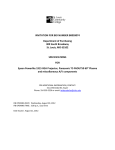
![[SPT-3000] e](http://vs1.manualzilla.com/store/data/005667089_1-a5f3766b3193f6552f250995926a69c5-150x150.png)

